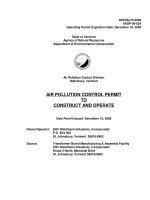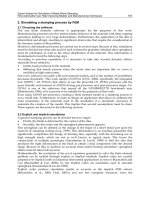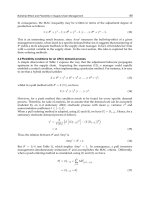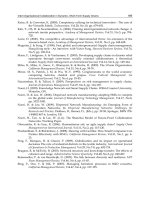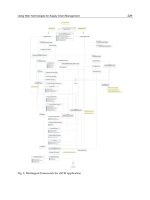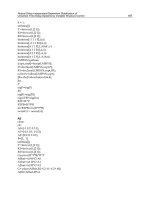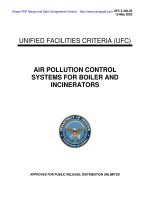Air Pollution Control Systems for Boiler and Incinerators Part 6 pot
Bạn đang xem bản rút gọn của tài liệu. Xem và tải ngay bản đầy đủ của tài liệu tại đây (180.74 KB, 10 trang )
TM 5-815-1/AFR 19-6
7-5
TM 5-815-1/AFR 19-6
7-6
7-3. Application reactants. Liquid effluent treatment and disposal are
a. Particulate removal. Scrubbers may be used as
control devices on incinerators and boilers for fly ash
collection. The plate, spray, venturi, and moving bed
types have been successfully applied; however, their
application has been limited because they require:
— more energy than dry particulate collection
devices of the same collection efficiency,
— water supply and recovery system,
— more extensive solid waste disposal system,
— system to control the scrubbing process in
response to gas flow rate changes.
b. In making decisions on applicability to a particular
process, figure 7-7 is useful in determining all
components which must be taken into consideration.
c. Gaseous removal. Scrubbers have been used pri-
marily for the removal of sulfur oxides in stack gases.
(See chapter 10 for a more detailed description of a. General conditions. When choosing construction
sulfur oxides (SO ) control techniques.) However, as materials for scrubber systems, certain pertinent oper-
x
new control systems are devised, simultaneous removal ating parameters should be considered. The metal sur-
of gases and particulate material will become the face of an exhaust gas or pollution control system will
accepted procedure for designing scrubbers for behave very differently in the same acid mist environ-
combustion processes. ment, depending on conditions of carrier gas velocity,
7-4. Treatment and disposal of waste oxidizing, and upon the presence of impurities. For
materials example, the presence of ferric or cupric iron traces in
Wet scrubber systems are designed to process exhaust
streams by transfer of pollutants to some liquid
medium, usually water seeded with the appropriate
therefore an essential part of every wet scrubber sys-
tem. Installation and maintenance of the associated
components can add appreciably to the system capital
and operating costs. The degree of treatment required
will depend upon the methods of disposal or recycle
and on existing regulations. Required effluent quality,
environmental constraints, and availability of disposal
sites must be established before design of a treatment
facility or the determination of a disposal technique can
proceed. In many industrial applications the scrubber
liquid wastes are combined with other plant wastes for
treatment in a central facility. Design of this waste
treatment should be by an engineer experienced in
industrial waste treatment and disposal.
7-5. Selection of materials
temperature, whether the conditions are reducing or
acids can dramatically reduce corrosion rates of
stainless steels and titanium alloys. On the other hand,
traces of chloride or fluoride in sulfuric acid can cause
TM 5-815-1/AFR 19-6
7-7
severe pitting in stainless steels. This condition is fre- resistant to oxidizing acid environments, but are
quently encountered in an incinerator which burns attached by acids under reducing conditions. The
large quantities of disposable polyvinyl chloride (PVC) equipment designer should select materials based on
materials. individual case conditions including temperature, abra-
b. Temperature. Corrosion rates generally increase sion, pH, etc.
with increases in exhaust temperatures. This is due to
the increased mobility of ions and increased reaction
rates. However, in cases where the corrosion process
is accelerated by the presence of oxygen, increasing the
acid temperature eventually boils out dissolved oxygen,
rapidly diminishing corrosion rate. This is the case with
Monel, a nickel-copper alloy.
c. Velocity. Often the corrosion resistance of an alloy
depends on the existence of an adhering oxide layer on
its surface. A high exhaust gas velocity can remove or
erode the surface layer. Once removed, this layer can-
not be renewed because the oxide film is washed away
as it forms.
d. State of oxidation. Under reducing condition,
Monel is very resistant to moderate sulfuric-acid con-
centrations. Under oxidizing conditions, or in the pres-
ence of oxidizing ions, however, very rapid corrosion
occurs. The reverse is true of stainless steels which are
7-6. Auxiliary equipment
a. Gas transport.
(1) Ducts and stacks. Large boiler plant stacks
have a wind shield of reinforced concrete or
of steel, with a separate inner flue or
numerous flues of steel, acid-resistant brick,
and occasionally, stainless steel. The space
between the inner flue and the outer wind
shield may be insulated with a mineral wool
wrapping. This is to prevent the condensa-
tion of acid dew on the inside of the metal
chimney, which occurs below dew point
temperature, and also to prevent acid “smut”
from being blown out of the chimney. Acid
smut is a term for ash particles contaminated
with acid. It is heavy and tends to fall out of
the gas plume soon after exiting from the
TM 5-815-1/AFR 19-6
7-8
stack. In smaller plants, stacks may be a pressure piping. Considerations must also be
single wall steel construction with insulation made for weatherproofing against freezing
and lagging on the outer surface. For wet conditions.
scrubbing practice, chimneys for vapor-satu- (2) Pumps. Centrifugal pumps are used to
rated gases containing corrosive substances supply the scrubbing liquid or recycled slurry
may be made of rubber-lined steel, to the scrubber nozzles at the required
fiberglass-reinforced resin or other volume flow rate and pressure. Where no
corrosion-resistant material. With materials solids are present in the liquid, bare metal
that have a limited maximum temperature, pumps, either iron or stainless steel
provisions must be made to protect the stack construction, are used. In recycle systems
from high temperatures because of loss of with solids in the liquid, special rubber-lined
scrubbing liquid. Chimney or stack velocities or hard-iron alloy pumps are used to control
are generally 30 ft/ sec to prevent re- erosion of the pump internals. These are
entrainment of moisture from the stack wall generally belt driven to allow selection of the
which would rain down around the plant. proper speed necessary for the design
Sometimes cones are fitted at the top to give capacity and head. Solids content must still
exit velocities as high as 75 ft/sec. The chief be controlled to limit the maximum slurry
reason for high velocities is to eject the gases consistency to meet the scrubber and pump
well away from the top of the stack to requirements.
increase the effective height and to avoid c. Entrainment separation. After the wetted gas
downwash. Downwash can damage the stream leaves the scrubbing section, entrained liquid
metal structure supporting the stack, the droplets must be removed. Otherwise they would rain
stack itself, or the outside steel of a lined out of the stack and fall on the surrounding area.
metal stack. (For a more detailed analysis of Removal can be by gravity separation in an expanded
the meteorological considerations involved vessel with lowered velocity or a cyclonic separator
in stack design, see chapter 4.) can swirl out the droplets against the vessel wall.
(2) Fans. In a wet scrubber system the preferred Knitted wire or plastic mesh demisters or chevron or
location for the boiler or incinerator “zig-zag” vanes can be located at the scrubber outlet to
induced-draft fan is upstream of the catch any droplets.
scrubber. This eliminates the need for d. Process measurement and control. The scrubber
special corrosion-resistant construction control system should be designed to follow variations
required to handle the wet downstream gas. in the boiler or incinerator gas flow and contaminant
The fan should be selected to resist build-up load to maintain outlet emissions in compliance with
of dry ash or erosion of the rotor surfaces. selected criteria.
For high dust load applications a radial blade (1) Measurements. Measurement of data from
or radial tip blade fan is more durable. In a the process to provide proper control should
dry scrubber application the fan should be include inlet gas flow rate, temperature and
downstream of the scrubber in the clean gas pressure, scrubber gas pressure drop, liquid
stream. Here a more efficient air-foil or pressure, flow rate, solids consistency, pH,
squirrel-cage rotor can be used. and outlet gas temperature. Selection of
b. Liquid transport. instrumentation hardware should be on an
(1) Pipework. For most scrubbing duties, the individual application basis.
liquid to be conveyed will be corrosive. (2) Control. Pressure drop across a scrubber can
There exists a wide variety of acid resistant be referenced as an indication of
pipework to choose from, but generally performance following initial or periodic,
speaking, rubber-lined steel pipe has high outlet gas testing. In a variable throat
versatility. It is easy to support, has the venturi, for instance, this pressure drop can
strength of steel, will withstand increases in be used to control the throat opening,
temperature for a short time and will not maintaining constant performance under
disintegrate from vibration or liquid varying gas volume flow rates. Measurement
hammer. Fiberglass filament wound plastic of scrubber slurry solids consistency can be
pipe is also suitable for a very wide range of used to control bleed-off of high solids slurry
conditions of temperature, pressure, and and make-up with fresh water. If sulfur
chemicals. The chief disadvantage of rubber- dioxide (SO ) is being controlled then
lined pipe is that it cannot be cut to size and measurement of scrubber liquid pH can
has to be precisely manufactured with control make-up of caustic to maintain
correct lengths and flange drilling. Site efficiency of SO removal. Complete
fabrication is not possible. Most piping is specification or design of a control system
manufactured to ANSI specifications for must be on a case-by-case basis.
2
2
TM 5-815-1/AFR 19-6
7-9
7-7. Advantages and disadvantages b. Disadvantages. The disadvantages of selecting
a. Advantages. The advantages of selecting scrub-
bers over other collection devices are:
— Capability of gas absorption for removal of
harmful and dangerous gases,
— High efficiency of particulate removal,
— Capability of quenching high temperature
exhaust gases,
— Capability of controlling heavy particulate
loadings,
scrubbers over other collection devices are:
— Large energy usage for high collection effi-
ciency,
— High maintenance costs,
— Continuous expenses for chemicals to
remove gaseous materials,
— Water supply and disposal requirements,
— Exhaust gas reheat may be necessary to
maintain plume dispersion,
— Weather proofing is necessary to prevent
freezeup of equipment.
TM 5-815-1/AFR 19-6
8-1
CHAPTER 8
ELECTROSTATIC PRECIPITATORS
8-1. Electrostatic precipitator (ESP) plate design. It has the advantage of collecting more
An electrostatic precipitator is a device which removes
particles from a gas stream. It accomplishes particle
separation by the use of an electric field which:
— imparts a positive or negative charge to the
particle,
— attracts the particle to an oppositely charged
plate or tube,
— removes the particle from the collection
surface to a hopper by vibrating or rapping
the collection surface.
8-2. Types of electrostatic precipitators
a. Two stage ESPs. Two stage ESPs are designed so single stage, parallel plate design. They are smaller in
that the charging field and the collecting field are inde- construction than hot precipitator types because they
pendent of each other. The charging electrode is handle smaller gas volumes due to the reduced tem-
located upstream of the collecting plates. Two stage perature. Cold precipitators are most effective at col-
ESPs are used in the collection of fine mists. lecting particles of low resistivity since particle
b. Single stage ESPs. Single stage ESPs are designed resistance to collection is greater at lower tem-
so that the same electric field is used for charging and peratures. These precipitators are subject to corrosion
collecting particulate s Single stage ESPs are the most due to the condensation of acid mist at the lower tem-
common type used for the control of particulate peratures.
emissions and are either of tube or parallel plate type
construction. A schematic view of the tube and parallel
plate arrangement is given in figure 8-1.
(1) The tube type precipitator is a pipe with a
discharge wire running axially through it. Gas stream entering the precipitator. Wet precipitators
flows up through the pipe and collected par- enhance the collection efficiency of particulates by
ticulate is discharged from the bottom. This reducing reentrainment from the collection plates. Care
type of precipitator is mainly used to handle should be taken so that water addition does not lower
small gas volumes. It possesses a collection gas temperature below the dewpoint temperature, thus
efficiency comparable to the parallel plate allowing the formation of acids. A wet precipitator can
types, usually greater than 90 percent. Water be of either plate or tube type construction.
washing is frequently used instead of rapping
to clean the collecting surface. 8-4. Applications
(2) Parallel plate precipitators are the most com-
monly used precipitator type. The plates are
usually less than twelve inches apart with the
charging electrode suspended vertically
between each plate. Gas flow is horizontal
through the plates.
8-3. Modes of operation.
All types of ESPs can be operated at high or low tem- reviewed.
peratures, with or without water washing (table 8-1).
a. Hot precipitation. A hot precipitator is designed
to operate at gas temperatures above 600 degrees industry to control emissions from coal-fired boilers.
Fahrenheit and is usually of the single stage, parallel Cold type precipitators are the prevalent type because
particulate from the hot gas stream because particle
resistance to collection decreases at higher
temperatures. The ability to remove particles from the
collection plates and hoppers is also increased at these
temperatures. However, hot precipitators must be large
in construction in order to accommodate the higher
specific volume of the gas stream.
b. Cold precipitation. Cold precipitators are
designed to operate at temperatures around 300
degrees Fahrenheit. The term “cold” is applied to any
device on the low temperature side of the exhaust gas
heat exchanger. Cold ESPs are also generally of the
c. Wet precipitation. A wet precipitator uses water
to aid in cleaning the particulate collection plates. It
may employ water spray nozzles directed at the collec-
tion plates, or inject a fine water mist into the gas
Electrostatic precipitators are among the most widely
used particulate control devices. They are used to con-
trol particulate emissions from the electric utility
industry, industrial boiler plants, municipal incin-
erators, the non-ferrous, iron and steel, chemical,
cement, and paper industries. It is outside the scope of
this manual to include all of these application areas.
Only applications to boilers and incinerators will be
a. Boiler application. Parallel plate electrostatic
precipitators are commonly employed in the utility
TM 5-815-1/AFR 19-6
8-2
they are most easily retrofitted. In the design of new c. Incinerator application. Until relatively recently,
installations, the use of hot precipitators has become ESPs were used for pollution control on incineration
more common, because of the greater use of lower units only in Europe. In the United States, however, the
sulfur fuels. Low sulfur fuels have higher particle ESP is now being viewed as one of the more effective
resistivity and therefore particulate emissions are more methods for the control of emissions from incinerators.
difficult to control with cold precipitation. Figure 8-2 The major problem associated with the use of
may be used for estimating whether hot precipitators or precipitators on incinerators is high gas temperatures.
cold precipitators should be selected for a particular Temperatures up to 1800 degrees Fahrenheit can be
sulfur content of coal. encountered at the incinerator outlet. These tem-
b. Wood refuse boiler applications. An ESP can be peratures must be reduced before entering a pre-
used for particulate collection on a wood fired boiler cipitator. Several methods can be used to accomplish
installation if precautions are taken for fire prevention. this temperature reduction:
The ESP should be preceded by some type of — mixing of the gas with cooler air;
mechanical collection device to prevent hot glowing — indirect cooling such as waste heat boilers,
char from entering the precipitator and possibly starting — evaporative cooling in which droplets of
a fire. water are sprayed into the gas.
TM 5-815-1/AFR 19-6
8-3
8-5. Performance c. Bus sections. The number of energized bus sec-
The performance of an electrostatic precipitator is pre-
dominantly affected by particle resistivity, particle size,
gas velocity, flow turbulence, and the number of
energized bus sections (electrically independent sec-
tions) in operation.
a. Particle resistivity. Particle resistivity is an elec-
trical property of a particle and is a measure of its
resistance of being collected. Particle resistivity is
affected by gas temperature, humidity, sodium content,
and sulfur trioxide (SO ) content. See figure 8-3.
3
b. Collection plate area. Collection plate area, and
gas volume, affect electrostatic precipitator perform-
ance. The basic function relating these factors is shown
in equation 8-1.
tions in a precipitator has an effect upon collection
efficiency. A power loss in one energized bus section
will reduce the effectiveness of the precipitator. See
figure 8-4.
d. Turbulence. Turbulence in the gas flow through
an electrostatic precipitator will decrease its collection
efficiency. For proper operation all segments of the
flow should be within 25 percent of the mean flow
velocity.
8-6. Description of components
a. Shell. The shell of an ESP has three main func-
tions: structural support, gas flow containment, and
insulation. Shell material is most commonly steel; if
necessary, insulation can be applied to the exterior to
prevent heat loss. Brick or concrete linings can be
installed on shell interiors if gas stream corrosion of the
metal may occur. Corrosion resistant steel can also be
used as a lining, but the cost may be uneconomical and
at times prohibitive. Since the shell is also used for
structural support, normal civil engineering precautions
should be taken in the design.
b. Weighted wire discharge electrodes. Wires vary
in type, size, and style. Provision is made to keep the
TM 5-815-1/AFR 19-6
8-4
discharge wire from displacement by attachment to a trodes are supported from the top and kept in
suspended weight. The wires can be made stiff consist- alignment by guides at the bottom. Rigid elec-
ing of a formed sheet, or they can be simple variations trodes are the least susceptible to breakage.
of the normal straight round wire such as being barbed c. Collection electrodes. There are numerous types
or pronged. Steel alloys are commonly used for wire of collection electrodes designed to minimize
construction, but actually any conducting material with reentrainment and prevent sparking. The material used
a proper configuration and sufficient tensile strength in construction, however, must be strong enough to
can be used. withstand frequent rapping. In order to insure correct
(1) Rigid frame discharge electrodes. Rigid electrode application, it is wise to see if the electrode
frame designs incorporate a framework which chosen has exhibited good performance at similar
supports the discharge electrodes. By using installations.
the rigid frame design the need for wire
weights is eliminated since the frame keeps
the wires properly supported and aligned.
(2) Rigid electrodes. The rigid electrode design
uses electrodes that have sufficient strength to
stay in alignment their entire length. The elec-
d. Hoppers. A hopper is used to collect ash as it falls
from the precipitator. The hopper should be designed
using precautions against corrosion in the precipitator
as any leakage due to corrosion will enhance entrain-
ment. If the precipitator is dry, a hopper angle should
be chosen that will prevent bridging of collected dust.
TM 5-815-1/AFR 19-6
8-5
Hoppers must be sized so that the amount of dust cipitator design is installed with a proven ductwork
collected over a period of time is not great enough to arrangement.
overflow and be reentrained. Seals also must be pro-
vided around the outlet to prevent any air leakage. If
the precipitator is wet, the hopper should allow
removal of sludge in a manner compatible with the
overall removal system. In general the collected dust in
the hoppers is more free flowing when kept hot. The
hop-pers should be insulated and should have heaters
to maintain the desired temperatures. Hoppers heaters
will also prevent the formation of acids that may occur
at low temperatures. Provisions should be made for
safe rodding out the hoppers should they become
plugged.
e. Rappers. Rappers are used to remove dust from
the discharge and collection electrodes. Rappers are
usually one of two types, impulse or vibrator. The
vibrator type removes dust from the discharge elec-
trode by imparting to it a continuous vibration energy.
They are used to remove dust from the collection elec-
trodes. Impulse rappers consist of electromagnetic
solenoids, motor driven cams, and motor driven ham-
mers. Important features to note in choosing rappers
are long service life without excessive wear and
flexible enough operation to allow for changing
precipitator operating conditions. Low intensity
rapping of plates (on the order of one impact per
minute) should be used whenever possible to avoid
damage to the plates. visual inspection of the effect of
rapping on reentrainment is usually sufficient to
determine a good rapping cycle.
f. High tension insulators. High tension insulators
serve both to support the discharge electrode frame
and also to provide high voltage insulation. The mate-
rials used are ceramic, porcelain, fused silica and
alumina. Alumina is the most common. The insulators
must be kept clean to prevent high voltage shorting and
resultant equipment damage. Compressed air or steam
can be used for this purpose.
g. Four point suspension. Rigid electrode and rigid
frame units may utilize a four point suspension system
to support the discharge electrode framework in each
chamber. This type of suspension system assures a
better alignment of the discharge and collection elec-
trodes. This in turn provides a more consistent opera-
tion.
h. Distribution devices. Perforated plates, baffles or
turning vanes are usually employed on the inlet and
outlet of an ESP to improve gas distribution. Improper
distribution can cause both performance and corrosion
problems. These distribution devices may require rap-
pers for cleaning.
i. Model testing. Gas flow models are used to deter-
mine the location and type of distribution devices. The
models may include both the inlet and outlet ductwork
in order to correctly model the gas flow characteristics.
Gas flow studies may not be required if a proven pre-
8-7 Control systems
The electric power control system is the most impor-
tant component system of any E SP. The basic compo-
nents of this system are: step-up transformer; high
voltage rectifier; voltage and amperage controls; and
sensors.
a. Automatic power control. By utilizing a signal
from a stack transmissionmeter the power level in the
precipitator can be varied to obtain the desired perfor-
mance over a wide range of operating conditions.

